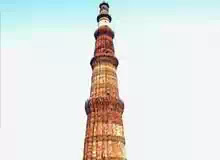Qutub Minar is the highest stone tower in India. The construction of
the Qutub Minar was started by Qutub-ud-Din Aibak in 1199 and it was
finished by his successor and son-in-law, Iltutmish. The Qutub Minar
was named after the Sufi saint, Khwaja Qutubuddin Bakhtiyar Kaki.
Though the exact purpose of the Qutb Minar is not known but it is
believed that it served as a minaret to the adjoining mosque and was
used by the muezzins to call the faithful to prayer.
Qutub Minar was built in red and buff sandstone and covered with
intricate carvings and verses from the holy Quran. All the five
storeys of Qutub Minar are surrounded by a projected balcony and
supported by stone brackets, which are decorated with honeycomb
designs. TheQutub Minar is 72.5 meters high and one has379 steps. The
diameter of the base of the Qutub Minar is 14.3 meters while the top
floor's diameter measures 2.7 meters.
There are numerous inscriptions on the Qutub Minar. These inscriptions
are in Arabicand Nagari characters. According to one inscription, the
Qutub Minar was repaired by Firoz Shah Tughlaq (AD 1351-88), the
Tughlaq ruler of the Delhi Sultanate. Sikandar Lodi (AD 1489-1517)
also got the Qutub Minar repaired. Another repair work was undertaken
byMajor R. Smith in 1829. The Qutub Minar was built on the ruins of
Lal Kot, the Red Citadel in the city of Dhillika, the capital of the
Tomar and Chauhana Rajputs, the last Hindu rulers of Delhi.
In the Qutub Minar complex, there are manyother remarkable buildings
and structures,including the Quwwat-ul-Islam mosque. The
Quwwat-ul-Islam mosque was the first mosque built in India. It was
built by Qutub-ud-din Aybak using materials of 27 Jain and Hindu
temples. There is also the famous Alai Darwaza at the entrance of the
Quwwat-ul-Islam mosque. It was built by Ala-ud-din Khalji. To the west
of the Quwwat-ul-Islam mosque is the tomb of Iltutmish. Close to the
mosque is the Ironpillar, one of Delhi's most curious structures. It
is said to be erected in the 4th century AD by the Gupta King,
Chandragupta II (375-413).

No comments:
Post a Comment